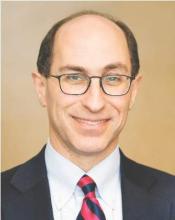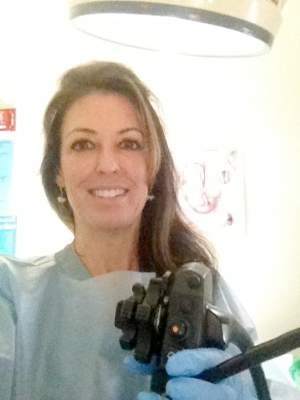User login
BOSTON – Gastroenterologists need to recognize that obesity is not one but multiple diseases and band together with other specialists in an interdisciplinary fashion to develop workable plans for long-term weight control, according to a panel of experts at the 2016 AGA Tech Summit, which is sponsored by the AGA Center for GI Innovation and Technology.
More than one-third of U.S. adults have obesity, at a medical cost of between $147 and $300 billion annually, according to the Centers for Disease Control and Prevention. There are many reasons people suffer from obesity, said Dr. Robert Fanelli, chief of minimally invasive surgery and surgical endoscopy at the Guthrie Clinic in Sayre, Pa. These range from poor diet to genetics, and, accordingly, physicians are going to have to turn to personalized care.
“The time has come for gastroenterologists to play a role in addressing this crisis,” said Dr. Sarah Streett, clinical associate professor of medicine at Stanford (Calif.) University. “Gastroenterologists are uniquely positioned to help in this area because we are, by training, internists, digestive disease specialists, and endoscopists, and endoscopic bariatric therapies are entering the armamentarium of tools to treat obesity,” she added.
Over the last few decades, GI experts’ attention has focused on colon cancer screening and significant innovations in the areas of endoscopic therapeutics and the treatment of hepatitis and inflammatory bowel disease, Dr. Streett said, “but many in GI appreciate that obesity is a root cause for so many of the conditions that we’re already treating: esophageal reflux and its complications, fatty liver disease, gallbladder disease, and gastrointestinal cancers.”
Because the disease is complex, said Dr. Streett, who is also the chair of the AGA Practice Management and Economics Committee, it’s imperative to work collaboratively with others, including obesity medicine specialists, dietitians, counselors, psychologists, and bariatric surgeons, to create a continuum of care tailored to patients’ individual needs, with good nutrition, physical activity, and stress reduction as central tenets.
AGA – in conjunction with the Society of American Gastrointestinal and Endoscopic Surgeons, the Obesity Society, and the North American Society for Pediatric Gastroenterology, Hepatology and Nutrition – is developing a program to guide gastroenterologists who want to develop comprehensive care management programs to treat obesity with a multimodal approach, she said. The initiative, called “POWER: Practice Guide on Obesity and Weight Management, Education and Resources,” will be made available on the AGA website later this year.
For patients in need, there are safe, robust surgical options to manage obesity, including gastric bypass and sleeve gastrectomy, said Dr. Kevin Reavis, a bariatric surgeon at the Oregon Clinic in Portland. The safety record for bariatric surgery is now on par with elective gallbladder surgery and matches or betters heart surgery, he said. A less invasive option is the endoscopic placement of devices like gastric balloons that generate an early sense of satiety by applying pressure to the upper stomach.
Moving toward the future, there is a lot of “out of the box thinking” that has led to research into ways to alter consumption and digestion of food with such approaches as blocking the vagus nerve or employing deep brain stimulation. Although some devices or interventions are designed to block calories from being absorbed from the GI tract, others may be able to reset patients’ metabolic balance, enabling easier weight loss and maintenance.
Physicians’ understanding of obesity is changing, said Dr. Lee Kaplan, director of the Obesity, Metabolism and Nutrition Institute at Massachusetts General Hospital, Boston. “We now understand that the body has an elaborate and powerful regulatory system that seeks to maintain a stable amount of fat,” a phenomenon he characterized as “the fat mass set point.”
Changes in modern society, including the type of foods we eat, lack of exercise, disturbed sleep, increased stress, and medications that stimulate appetite, all send aberrant signals to the brain, causing it to seek too high a fat mass, he said. Any therapy that is to be successful must lower that set point.
Different from other heterogeneous disorders like cancer, it’s not yet clear which treatments will work best for which types of obesity, Dr. Kaplan noted. Meanwhile, “we’re recommending more and more that we approach obesity in the same way that we approach any other disease, which is to start with lifestyle changes,” he said, “and if that doesn’t work, to move on to more classically medical approaches, including medications and surgery.”
Once an effective treatment is implemented, continuing care is essential. Obesity is not cured with current treatments, which means that patients require ongoing support.
After weight is reduced, “we abandon patients as a matter of routine,” said Dr. Kaplan, noting that this is not the case in other serious chronic diseases. This is one aspect of obesity care that “we must change.”
Dr. Kaplan receives consulting fees from Eisai, Ethicon, GI Dynamics, Novo Nordisk, and Vivus, and has an ownership interest in GI Dynamics. Dr. Fanelli is a part owner of Allurion Technologies, a company that manufacturers an intragastric balloon for weight loss, and an advisor to EndoGastric Solutions. Dr. Streett and Dr. Reavis reported no relevant financial disclosures.
BOSTON – Gastroenterologists need to recognize that obesity is not one but multiple diseases and band together with other specialists in an interdisciplinary fashion to develop workable plans for long-term weight control, according to a panel of experts at the 2016 AGA Tech Summit, which is sponsored by the AGA Center for GI Innovation and Technology.
More than one-third of U.S. adults have obesity, at a medical cost of between $147 and $300 billion annually, according to the Centers for Disease Control and Prevention. There are many reasons people suffer from obesity, said Dr. Robert Fanelli, chief of minimally invasive surgery and surgical endoscopy at the Guthrie Clinic in Sayre, Pa. These range from poor diet to genetics, and, accordingly, physicians are going to have to turn to personalized care.
“The time has come for gastroenterologists to play a role in addressing this crisis,” said Dr. Sarah Streett, clinical associate professor of medicine at Stanford (Calif.) University. “Gastroenterologists are uniquely positioned to help in this area because we are, by training, internists, digestive disease specialists, and endoscopists, and endoscopic bariatric therapies are entering the armamentarium of tools to treat obesity,” she added.
Over the last few decades, GI experts’ attention has focused on colon cancer screening and significant innovations in the areas of endoscopic therapeutics and the treatment of hepatitis and inflammatory bowel disease, Dr. Streett said, “but many in GI appreciate that obesity is a root cause for so many of the conditions that we’re already treating: esophageal reflux and its complications, fatty liver disease, gallbladder disease, and gastrointestinal cancers.”
Because the disease is complex, said Dr. Streett, who is also the chair of the AGA Practice Management and Economics Committee, it’s imperative to work collaboratively with others, including obesity medicine specialists, dietitians, counselors, psychologists, and bariatric surgeons, to create a continuum of care tailored to patients’ individual needs, with good nutrition, physical activity, and stress reduction as central tenets.
AGA – in conjunction with the Society of American Gastrointestinal and Endoscopic Surgeons, the Obesity Society, and the North American Society for Pediatric Gastroenterology, Hepatology and Nutrition – is developing a program to guide gastroenterologists who want to develop comprehensive care management programs to treat obesity with a multimodal approach, she said. The initiative, called “POWER: Practice Guide on Obesity and Weight Management, Education and Resources,” will be made available on the AGA website later this year.
For patients in need, there are safe, robust surgical options to manage obesity, including gastric bypass and sleeve gastrectomy, said Dr. Kevin Reavis, a bariatric surgeon at the Oregon Clinic in Portland. The safety record for bariatric surgery is now on par with elective gallbladder surgery and matches or betters heart surgery, he said. A less invasive option is the endoscopic placement of devices like gastric balloons that generate an early sense of satiety by applying pressure to the upper stomach.
Moving toward the future, there is a lot of “out of the box thinking” that has led to research into ways to alter consumption and digestion of food with such approaches as blocking the vagus nerve or employing deep brain stimulation. Although some devices or interventions are designed to block calories from being absorbed from the GI tract, others may be able to reset patients’ metabolic balance, enabling easier weight loss and maintenance.
Physicians’ understanding of obesity is changing, said Dr. Lee Kaplan, director of the Obesity, Metabolism and Nutrition Institute at Massachusetts General Hospital, Boston. “We now understand that the body has an elaborate and powerful regulatory system that seeks to maintain a stable amount of fat,” a phenomenon he characterized as “the fat mass set point.”
Changes in modern society, including the type of foods we eat, lack of exercise, disturbed sleep, increased stress, and medications that stimulate appetite, all send aberrant signals to the brain, causing it to seek too high a fat mass, he said. Any therapy that is to be successful must lower that set point.
Different from other heterogeneous disorders like cancer, it’s not yet clear which treatments will work best for which types of obesity, Dr. Kaplan noted. Meanwhile, “we’re recommending more and more that we approach obesity in the same way that we approach any other disease, which is to start with lifestyle changes,” he said, “and if that doesn’t work, to move on to more classically medical approaches, including medications and surgery.”
Once an effective treatment is implemented, continuing care is essential. Obesity is not cured with current treatments, which means that patients require ongoing support.
After weight is reduced, “we abandon patients as a matter of routine,” said Dr. Kaplan, noting that this is not the case in other serious chronic diseases. This is one aspect of obesity care that “we must change.”
Dr. Kaplan receives consulting fees from Eisai, Ethicon, GI Dynamics, Novo Nordisk, and Vivus, and has an ownership interest in GI Dynamics. Dr. Fanelli is a part owner of Allurion Technologies, a company that manufacturers an intragastric balloon for weight loss, and an advisor to EndoGastric Solutions. Dr. Streett and Dr. Reavis reported no relevant financial disclosures.
BOSTON – Gastroenterologists need to recognize that obesity is not one but multiple diseases and band together with other specialists in an interdisciplinary fashion to develop workable plans for long-term weight control, according to a panel of experts at the 2016 AGA Tech Summit, which is sponsored by the AGA Center for GI Innovation and Technology.
More than one-third of U.S. adults have obesity, at a medical cost of between $147 and $300 billion annually, according to the Centers for Disease Control and Prevention. There are many reasons people suffer from obesity, said Dr. Robert Fanelli, chief of minimally invasive surgery and surgical endoscopy at the Guthrie Clinic in Sayre, Pa. These range from poor diet to genetics, and, accordingly, physicians are going to have to turn to personalized care.
“The time has come for gastroenterologists to play a role in addressing this crisis,” said Dr. Sarah Streett, clinical associate professor of medicine at Stanford (Calif.) University. “Gastroenterologists are uniquely positioned to help in this area because we are, by training, internists, digestive disease specialists, and endoscopists, and endoscopic bariatric therapies are entering the armamentarium of tools to treat obesity,” she added.
Over the last few decades, GI experts’ attention has focused on colon cancer screening and significant innovations in the areas of endoscopic therapeutics and the treatment of hepatitis and inflammatory bowel disease, Dr. Streett said, “but many in GI appreciate that obesity is a root cause for so many of the conditions that we’re already treating: esophageal reflux and its complications, fatty liver disease, gallbladder disease, and gastrointestinal cancers.”
Because the disease is complex, said Dr. Streett, who is also the chair of the AGA Practice Management and Economics Committee, it’s imperative to work collaboratively with others, including obesity medicine specialists, dietitians, counselors, psychologists, and bariatric surgeons, to create a continuum of care tailored to patients’ individual needs, with good nutrition, physical activity, and stress reduction as central tenets.
AGA – in conjunction with the Society of American Gastrointestinal and Endoscopic Surgeons, the Obesity Society, and the North American Society for Pediatric Gastroenterology, Hepatology and Nutrition – is developing a program to guide gastroenterologists who want to develop comprehensive care management programs to treat obesity with a multimodal approach, she said. The initiative, called “POWER: Practice Guide on Obesity and Weight Management, Education and Resources,” will be made available on the AGA website later this year.
For patients in need, there are safe, robust surgical options to manage obesity, including gastric bypass and sleeve gastrectomy, said Dr. Kevin Reavis, a bariatric surgeon at the Oregon Clinic in Portland. The safety record for bariatric surgery is now on par with elective gallbladder surgery and matches or betters heart surgery, he said. A less invasive option is the endoscopic placement of devices like gastric balloons that generate an early sense of satiety by applying pressure to the upper stomach.
Moving toward the future, there is a lot of “out of the box thinking” that has led to research into ways to alter consumption and digestion of food with such approaches as blocking the vagus nerve or employing deep brain stimulation. Although some devices or interventions are designed to block calories from being absorbed from the GI tract, others may be able to reset patients’ metabolic balance, enabling easier weight loss and maintenance.
Physicians’ understanding of obesity is changing, said Dr. Lee Kaplan, director of the Obesity, Metabolism and Nutrition Institute at Massachusetts General Hospital, Boston. “We now understand that the body has an elaborate and powerful regulatory system that seeks to maintain a stable amount of fat,” a phenomenon he characterized as “the fat mass set point.”
Changes in modern society, including the type of foods we eat, lack of exercise, disturbed sleep, increased stress, and medications that stimulate appetite, all send aberrant signals to the brain, causing it to seek too high a fat mass, he said. Any therapy that is to be successful must lower that set point.
Different from other heterogeneous disorders like cancer, it’s not yet clear which treatments will work best for which types of obesity, Dr. Kaplan noted. Meanwhile, “we’re recommending more and more that we approach obesity in the same way that we approach any other disease, which is to start with lifestyle changes,” he said, “and if that doesn’t work, to move on to more classically medical approaches, including medications and surgery.”
Once an effective treatment is implemented, continuing care is essential. Obesity is not cured with current treatments, which means that patients require ongoing support.
After weight is reduced, “we abandon patients as a matter of routine,” said Dr. Kaplan, noting that this is not the case in other serious chronic diseases. This is one aspect of obesity care that “we must change.”
Dr. Kaplan receives consulting fees from Eisai, Ethicon, GI Dynamics, Novo Nordisk, and Vivus, and has an ownership interest in GI Dynamics. Dr. Fanelli is a part owner of Allurion Technologies, a company that manufacturers an intragastric balloon for weight loss, and an advisor to EndoGastric Solutions. Dr. Streett and Dr. Reavis reported no relevant financial disclosures.
AT THE AGA 2016 TECH SUMMIT



